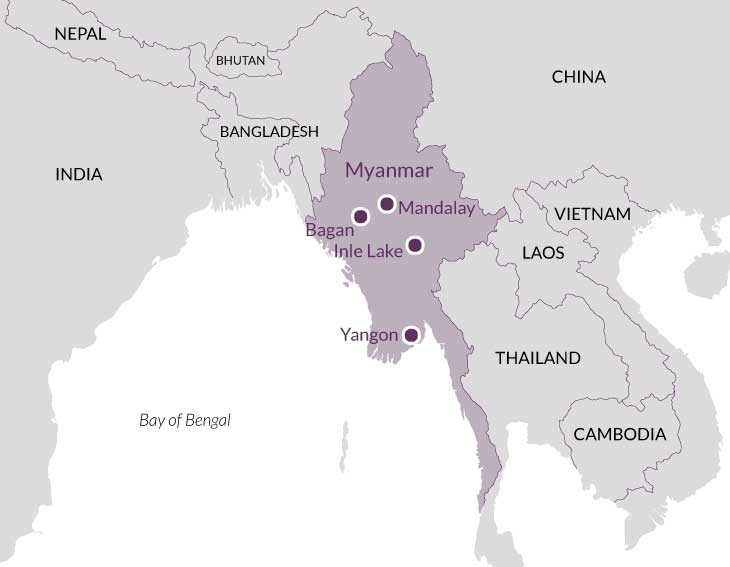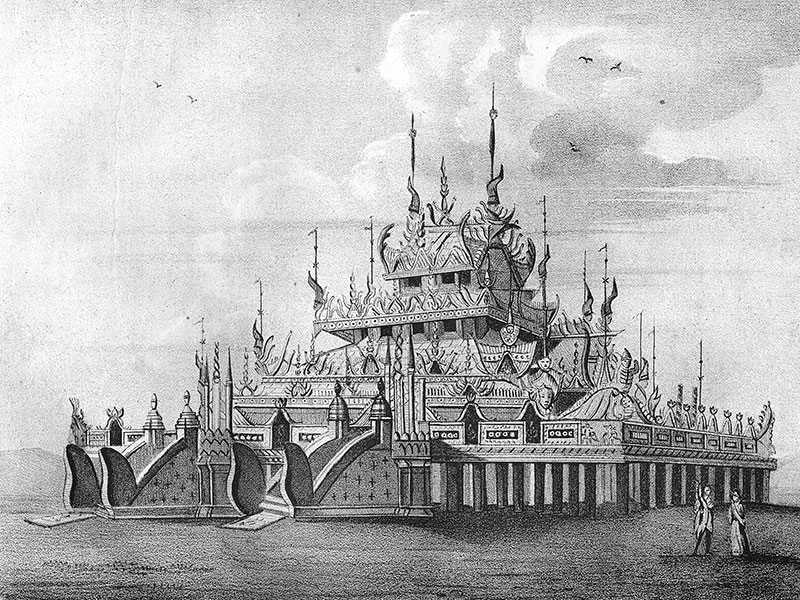Overview
Myanmar – or Burma, as it was called when ruled by the British – is a land of living history. Teak monasteries have withstood weathering and terracotta stupas have endured earthquakes while ancient customs have become woven into the fabric of contemporary daily life.
The Myanmar we see today is a complex tapestry of the tangible and intangible, evocative vestiges of fallen kingdoms and empires and simple spirituality infusing quotidian concerns. From the eleventh-century Kingdom of Pagan to Mandalay, the last of Burma’s royal capitals, and colonial Yangon (Rangoon), the tour shows the whole gamut of material culture of the country, and reveals the influences that have shaped modern Myanmar.
Theravada Buddhism has had an enormous influence on the country. The richest concentration of its art and architecture is to be found at Bagan. The building frenzy that occurred on these plains in the eleventh century coincided with King Anawratha’s unification of Burma and the region’s transition to Theravada Buddhist practice. Completed in 1057, Shwesandaw is square and squat, more temple than pagoda, far removed from the Indian models that inspired it. By the end of Anawratha’s reign a prototype for Burmese pagoda design had evolved. Over 3,000 monasteries and stupas survive from three centuries of construction, creating an unforgettable panorama.
North-east from Bagan along the Ayeyarwady (Irrawaddy) River is Mandalay. This is the land of capitals; hilltop Sagaing, Amarapura, Ava and finally Mandalay itself have all been seats of power. Their legacy is clear to see. The Shwenandaw Kyaung is an exquisitely carved pavilion, formerly part of the royal palace, and close by is the unique mile-long bridge built across Taungthaman Lake by U Bein in 1850; the longest teak bridge in the world.
Myanmar is renowned for its ethnic diversity and has 135 distinct groups within its borders. Inle Lake is home to the Intha people who carry on a way of life barely changed for centuries – houses are raised over the water on stilts, crops are grown on floating beds of water-weed and monks are paddled in wooden canoes from home to home to collect their daily alms. In the surrounding villages young boys conduct their Shin Byu, or novitiation ceremony, regaled in golden robes and drawn on brightly decorated bullock carts on their way to the monastery.
This tour aims to present the essence of Myanmar, offering an insight into this mysterious ancient land that only recently has opened to the modern world. The faded grandeur of colonial Yangon is juxtaposed with the natural serenity of Inle Lake, imposing gilt Buddhist pagodas with nat spirit shrines.
Day 1
Yangon. The tour begins in Yangon with an introductory lecture at c. 2.00pm (flights from London are not included see 'Practicalities'. Your room is available from 2.00pm on 21st October). After lunch, visit Shwedagon Pagoda, a dreamlike structure in existence by the 11th century and covered with over 50 tonnes of gold leaf. First of two nights in Yangon.
Day 2
Yangon. A morning’s walk provides a survey of the colonial core of Yangon’s administrative buildings, including the Secretariat, site of General Aung San’s assassination in July 1947, and the Inland Waterways Department, former home of the Irrawaddy Flotilla Company. In the afternoon visit the National Museum housing the Lion Throne, and Bogyoke Aung San Museum, the family home of Aung San Suu Kyi.
Day 3
Bagan. Early morning flight from Yangon to Bagan (MYP Airlines). Visit Ananda Temple; on a Greek cross plan, it is one of the four great Buddhist monuments of Myanmar. After lunch by the banks of the Ayeyarwady River, explore Bagan’s smaller, less-visited pagodas and stupas. Some of these display fine murals and stucco work. First of two nights in Bagan.
Day 4
Mount Popa. South-east of Bagan rises lush Mount Popa, home of the nats: spirit gods, part of an intricate web of animism that exists alongside Buddhism. A walk through Popa village visits the shrines and reveals how nat culture is deeply ingrained. In the afternoon there is free time to revisit the pagodas and temples of Bagan.
Day 5
Mandalay. Early morning flight to Mandalay. On arrival, walk across U Bein’s teak bridge, built in 1850 from teak reclaimed from Inwa palace. After lunch take a leisurely boat ride along the Ayeyarwady to Mingun. It was here that King Bodawpaya began constructing a mammoth pagoda; should it have been finished it would have stood 150 metres high. The bell accompanying the pagoda was the heaviest functioning bell in the world at several times in history. Dinner takes the form of a barbecue on a sandbank. First of three nights in Mandalay.
Day 6
Amarapura, Sagaing. Amarapura Mahagandayon Kyaung is an important teaching monastery home to some 1300 monks and novices. In the afternoon, continue to Sagaing Hill. U Min Thonze has 45 Buddha images, one for each stage of his life, as well as offering views over Mandalay city.
Day 7
Mandalay. This morning focuses on Mandalay’s royal centre. Shwenandaw Kyaung, or the Golden Palace Monastery, was originally part of King Mindon’s palace. It was dismantled and moved to its current location by his son, Thibaw Min, in 1880. The image of the Buddha at Mahamuni temple was brought from Arakan in modern Rakhine State and was reportedly embraced by Gautama Siddartha himself.
Day 8
Pindaya, Inle Lake. Morning flight from Mandalay to Heho. A beautiful drive leads to Pindaya cave where some 6,000 Buddha images are arranged among stalagmites. After lunch, continue to Inle Lake, which we reach by motorised canoe. First of three nights on Inle Lake.
Day 9
Inle Lake. The day is spent on the lake, travelling by motorised canoe. A five-day market circulates around the lake where farmers from the surrounding Shan mountains and fishermen congregate to sell their wares. Phaung Daw U pagoda is one of Myanmar’s principle shrines, with five golden Buddha images. Nga Phe Monastery contains fine carved Buddhas representing the diverse regional styles of Myanmar art.
Day 10
Inle Lake. The morning is spent on the lake, again by motorised canoe. Visit a typical silversmith workshop followed by the Shwe Indein Pagoda, a group of Buddhist pagodas commissioned during the reign of King Narapatisithu. The afternoon is free.
Day 11
Yangon. Morning flight from Heho to Yangon. After lunch there is free time for a return visit to Shwedagon Pagoda or Bogyoke Market (formerly Scott’s Market). In the evening there is a private viewing and dinner at Deitta Gallery. Located in a colonial building in downtown Yangon, this not-for-profit organisation supports independent documentary projects focusing on the social landscape of Myanmar. Overnight in Yangon.
Day 12
Yangon. The tour ends after breakfast. Transfer to the airport in time for the recommended flight to London.
Price, per person
Two sharing: £4,910. Single occupancy: £5,890.
Included
Domestic flights with MYP Airlines: Yangon to Bagan, Bagan to Mandalay, Mandalay to Heho and Heho to Yangon; travel by private coach, boat and motorised canoes; hotel accommodation as described below; breakfasts, 8 lunches and 8 dinners with wine or beer, water and coffee; all admissions; all tips; all taxes; the services of the lecturer, tour manager and the local guide.
Flights
International flights from London to Yangon and from Yangon to London, via Bangkok, are not included in the price of the tour. We send the recommended flight options when they are available to book (November 2019) and ask that you make your own flight reservation. Please ensure you have travel insurance that protects you in the unlikely event that the tour is cancelled.
Visas
Visas are required for most foreign nationals, and not included in the tour price. We will advise on the process.
Accommodation
Belmond Governor’s Residence, Yangon: 5-star coverted colonial-style 1920s mansion in the embassy quarter. Bagan Thiripyitsaya Sanctuary Resort, Bagan: luxury resort located on the Ayeyarwady River, walking distance from the pagodas. Mandalay Hill Resort: 4-star hotel at the foot of Mandalay Hill. Sanctum Inle Resort, Inle Lake: luxury resort in the backwaters of Inle lake. Single rooms are doubles for sole use throughout.
How strenuous?
A good level of fitness is essential. Unless you enjoy entirely unimpaired mobility, cope with everyday walking and stair-climbing without difficulty and are reliably sure-footed, this tour is not for you. There are four internal flights and embarking and disembarking boats requires stability. Average distance by coach per day: c. 22 miles.
Are you fit enough to join the tour?
Group size
Between 10 and 22 participants.
Travel advice
Before booking, please refer to the FCDO website to ensure you are happy with the travel advice for the destination(s) you are visiting.

'A well thought out, organised and excellent tour allowing visits to places of interest. Temples, stupas with their unique characters and caves with exquisite murals provided evidence of the historical, religious and artistic architecture of Myanmar.'
